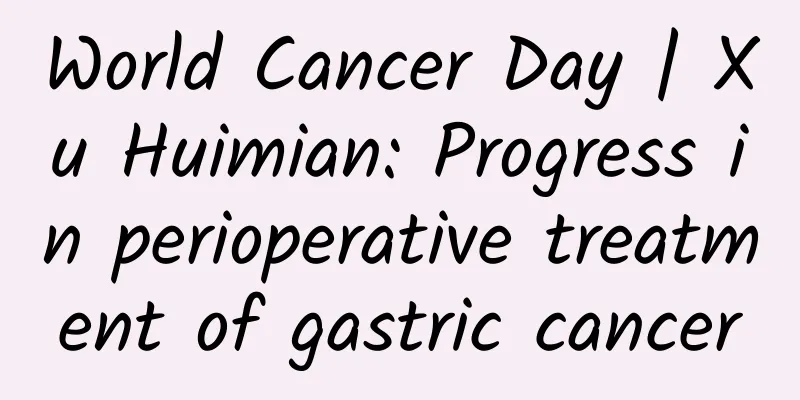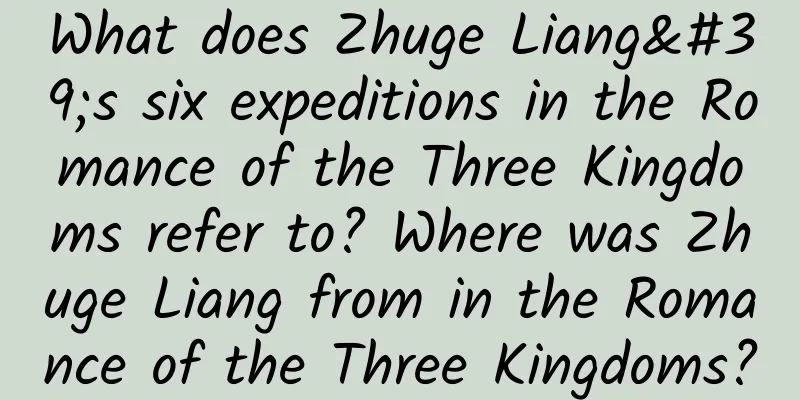World Cancer Day | Xu Huimian: Progress in perioperative treatment of gastric cancer

|
Xu Huimian Written by Gao Ziming and Xu Huimian, Department of Gastrointestinal Tumor Surgery, The First Affiliated Hospital of China Medical University The incidence of gastric cancer in my country is high, and the proportion of patients in the advanced and advanced stages is large. The choice of perioperative treatment options has always been a difficult problem in clinical practice. Neoadjuvant therapy can downstage the tumor, reduce the tumor volume, and reduce tumor activity, which is conducive to surgical resection, improve the surgical resection rate (R0) and pathological complete remission rate (pCR). At the same time, chemotherapy can also eliminate potential micrometastases in other parts, thereby improving local control rate and overall survival rate. Perioperative chemotherapy for advanced gastric cancer is routinely recommended in the NCCN, ESMO, and my country's CSCO guidelines. However, neoadjuvant chemotherapy and conversion therapy, as hot topics and concepts that are easily confused in recent years, are similar in treatment mode. However, the purpose of the former is to improve the surgical radicality of initially resectable patients by downstaging the tumor, while the latter strives to gain the opportunity for surgical resection in advanced cases. This article will review and summarize the two and explore the perioperative treatment model suitable for Chinese gastric cancer patients. Neoadjuvant therapy As we all know, the MAGIC and FNCLCC/FFCD studies established a standard model for neoadjuvant chemotherapy in the treatment of gastroesophageal adenocarcinoma by comparing the efficacy of perioperative chemotherapy and surgery alone in stage II/III gastric cancer in terms of survival, and also opened a new chapter in the perioperative treatment of gastric cancer. The results of MAGIC showed that compared with surgery alone, perioperative chemotherapy with the ECF (epirubicin, cisplatin, and fluorouracil) regimen can bring survival benefits; FNCLCC/FFCD clarified the significance of cisplatin + fluorouracil in neoadjuvant chemotherapy for gastric cancer. Based on the research results of the above two large randomized controlled trials, the NCCN Gastric Cancer Treatment Guidelines recommend neoadjuvant preoperative chemotherapy as a routine regimen for advanced gastric cancer (Class I evidence). However, there are still many controversies regarding the beneficiaries, optimal regimen, and treatment cycle of neoadjuvant chemotherapy, and important related clinical research results are being revealed one after another. The 2018 FLOT4 study is one of the most important studies on perioperative treatment of gastric cancer in recent years. For clinically resectable Siewert I-III adenocarcinoma of the stomach or gastroesophageal junction, the docetaxel-based three-drug FLOT regimen (docetaxel + oxaliplatin + fluorouracil) has significant advantages over ECF/ECX in pCR rate, OS and PFS, and has comparable safety, suggesting that docetaxel can replace epirubicin in the standard triple regimen for patients with localized gastric cancer who receive perioperative chemotherapy. In 2019, two landmark studies on neoadjuvant chemotherapy for gastric cancer were released - RESOLVE and PRODIGY. Among them, RESOLVE is a three-arm, randomized, multicenter phase III study led by Chinese scholars, aiming to compare the effect and safety of XELOX (Group A) or SOX (Group B) after D2 radical surgery and perioperative use of SOX (Group C); its results showed that for patients with cT4a/N+M0 or cT4b/NxM0 locally advanced gastric cancer, perioperative SOX chemotherapy can improve the 3-year disease-free survival rate compared with postoperative XELOX adjuvant chemotherapy; and in terms of postoperative adjuvant chemotherapy, the SOX regimen is non-inferior to the XELOX regimen. Based on this, the 2020 version of the CSCO guidelines lists the SOX perioperative regimen as a Level II recommendation (Level IB evidence). The results of PRODIGY in South Korea during the same period showed that for locally advanced gastric cancer of cT2-3N+M0 or cT4/NxM0, preoperative DOS neoadjuvant + postoperative S-1 adjuvant can significantly improve the patient's 3-year PFS rate compared with S-1 postoperative adjuvant chemotherapy. Therefore, the DOS regimen can also be used as a recommended regimen for neoadjuvant chemotherapy for locally advanced gastric cancer, and it is recommended as a Level II (Level IB evidence) in the 2020 version of the CSCO guidelines. The role of targeted drugs in neoadjuvant therapy has attracted much attention in recent years. For HER2+ locally advanced gastroesophageal adenocarcinoma, the HER-FLOT and NEOHX studies showed that the pCR rates of trastuzumab combined with FLOT or NEOHX were 23% and 8%, and the ORR of the latter could reach 39%. The results of the above two studies have preliminarily confirmed the therapeutic efficacy of HER2 monoclonal antibody combined with chemotherapy in the perioperative period of gastric cancer. In addition, the 2020 ESMO announced the results of the PETRARCA study, that is, FLOT combined with HER2 dual-target drugs (trastuzumab and pertuzumab) can effectively improve pCR and lymph node conversion rate, but the occurrence of serious adverse events also increased; there was no statistical difference between the two groups in R0 resection, postoperative complications, postoperative mortality and prognosis. However, considering the preliminary DFS of FLOT combined with dual targets, this regimen still has certain application prospects. As the role of immunotherapy in neoadjuvant chemotherapy becomes increasingly prominent, the ICONIC study found that the ICOS agonist JTX-2011 can cause tumor regression in some patients (2/8) and have a disease control period of at least 8.5 months. In addition, immune checkpoint inhibitors (ICIs) combined with neoadjuvant therapy, such as PD-L1 monoclonal antibody + FLOT, PD-1 monoclonal antibody + XELOX/FLOT regimen, etc., have shown a high pathological complete remission rate in patients with locally advanced gastric cancer, but the safety of immunotherapy in perioperative neoadjuvant therapy remains to be observed. The advantages of neoadjuvant chemotherapy are: 1. Downstaging and treating oligometastases, thereby improving the R0 resection rate and reducing the possibility of recurrence; 2. Good tolerance, which can effectively improve patient compliance; 3. Providing plans and basis for subsequent treatment. The 8th edition of the International Gastric Cancer Staging System officially established the ypTNM staging, thereby improving the application and evaluation system of neoadjuvant therapy in gastric cancer. However, in neoadjuvant therapy, problems such as inaccurate preoperative clinical staging and the possibility of overtreatment still need further optimization and exploration. Conversion therapy Nearly 30% of gastric cancer in my country is stage IV, and the opportunity for radical surgery has been lost at the time of the first visit, and the 5-year survival rate after surgery is only about 7%. Its treatment has always been a difficult point in the diagnosis and treatment of gastric cancer. In the past, this population mainly received palliative treatment, but the REGATTA trial showed that palliative/reduced-dose surgery could not improve the long-term survival of gastric cancer patients with incurable factors. For this part of patients, conversion therapy in recent years has shown good clinical application prospects, that is, through preoperative adjuvant therapy, some patients with initially unresectable or potentially resectable advanced gastric cancer have the opportunity for radical surgery. At the 57th Annual Meeting of the Japanese Society of Clinical Oncology, the FACO Alliance reported the results of a "China-Japan-Korea" retrospective cohort study (CONVO-GC-1). As a real-world study, its results confirmed the safety and feasibility of conversion therapy, especially the OS of patients with R0 resection can reach 56.6 months; and the survival of R1 and R2 resection is similar, which is a good supplement to the conclusion of the REGATTA study. Therefore, conversion therapy is the key to improving the long-term survival of advanced gastric cancer. However, translational therapy is still in its infancy, and there are still many challenges in terms of screening of beneficiary populations, timing of surgery, preoperative chemotherapy regimens, and the value of immunotherapy. The study of conversion therapy in peritoneal metastasis of gastric cancer is in full swing. Although the PHOENIX-GC Phase III study did not show statistical differences, the results after baseline correction still confirmed to a certain extent the clinical efficacy of the "intraperitoneal + intravenous paclitaxel combined with S-1" regimen for peritoneal metastasis of gastric cancer, especially in patients with moderate ascites, with a high pathological response rate. The domestic S-1 combined with PTX NIPS regimen showed that its 1-year survival rate was 58.8% and the R0 resection rate was 66.7%. Both conclusions show the value of intraperitoneal chemotherapy in conversion therapy of gastric cancer. In addition, Professor Yoshida proposed a classification system based on the biological behavior of gastric cancer peritoneal metastasis, that is, it is divided into 4 types according to the presence or absence of visible metastasis and the difficulty of surgical resection. Among them, type I is an indication for neoadjuvant therapy, while all type II, some type III and a small amount of type IV should be the main body of conversion therapy. Professor Yoshida subsequently studied 259 cases of peritoneal metastasis and confirmed that after preoperative chemotherapy, type II had the highest number of successful conversions and type IV had the lowest conversion success rate. Regarding para-aortic lymph nodes (No.16a2/b1), the Japanese Gastric Cancer Research Group conducted a series of studies such as JCOG9501, JCOGO001 and JCOG0405. The JCOG9501 study showed that D2+ lymph node dissection did not improve the survival rate compared with the D2 dissection range. Its results negated the value of preventive No.16a2/b1 dissection and shifted the focus of researchers to the possibility of "improving preoperative downstaging". As a follow-up plan of JCOG0001, JCOG0405 confirmed the effectiveness of the preoperative SP regimen (S1+CDDP), with a 3-year survival rate of 58.8%. Therefore, for patients with high-grade lymph node metastasis and para-aortic lymph node metastasis, SP chemotherapy combined with gastrectomy + para-aortic lymph node dissection is recommended as the standard treatment method by the 5th edition of the Japanese "Guidelines for the Treatment of Gastric Cancer". In conversion therapy, the use of a treatment regimen with a higher objective response rate is a key factor in achieving tumor transformation. However, several phase III studies have shown that the ORR value of chemotherapy regimens for advanced gastric cancer has always remained at 40%-50%, which has now become one of the difficulties in the treatment of gastric cancer. In recent years, the development of immunotherapy has provided the possibility of breaking through this bottleneck. For example, a domestic study used a combination of "albumin paclitaxel + S-1 + apatinib + PD-1" for the conversion treatment of stage IV gastric cancer. Among the 26 patients currently enrolled, the initial objective response rate exceeded 90%, with good results. Summarize In summary, for potentially resectable advanced gastric cancer, it is recommended to actively consider preoperative neoadjuvant therapy. For unresectable gastric cancer that meets the Yoshida classification, conversion therapy is a key way to improve the prognosis and survival of advanced gastric cancer, but it still faces many key issues that need to be addressed. In addition, in perioperative treatment, attention should be paid to the important value and clinical application of targeted drugs and immunotherapy, that is, based on therapeutic targets and TMB, PD-L1 and other levels, targeted drugs and ICIs are given to specific patients. This is the development trend of perioperative treatment of gastric cancer and a reflection of the concept of precision tumor treatment. |
<<: Little knowledge about white cardamom, cardamom and nutmeg
Recommend
Treatment of vaginitis in girls
In life, many young female friends, perhaps femal...
Introduction to the hazards of vaginitis
I believe that all female friends are not unfamil...
What to do if you have mild anemia during pregnancy
During pregnancy, women must ensure that their nu...
Did you know that cucumber is an amazing fruit with many benefits?
As they say, few foods are as cooling as cucumber...
What is the detailed list of ingredients for cold rice noodles? How to make cold rice noodles delicious and satisfying?
At present, people in various places are in dire ...
How to abort an ectopic pregnancy
Ectopic pregnancy is something that every woman o...
What are the symptoms of hernia in women
Hernias are relatively common in children. But di...
Can I eat yam and pork ribs soup when I am pregnant?
A woman's diet after pregnancy will be affect...
Is ovulation bleeding before or after ovulation?
Many women are not sure whether ovulation bleedin...
Medium-length bangs
Women generally have long hair, and bangs play a ...
What are some ways for girls to lose weight and train their abdominal muscles?
For female friends, they all hope to have a good ...
Small grains on the areola indicate pregnancy
Is there any connection between the small fleshy ...
Do you wash your vulva with pepper water every day?
You can use pepper water to wash the vulva, which...
What gynecological diseases can cause frequent urination?
Frequent urination can be divided into two reason...
What is the correct way to wash the vulva with metronidazole?
Whether male or female, you must pay attention to...









